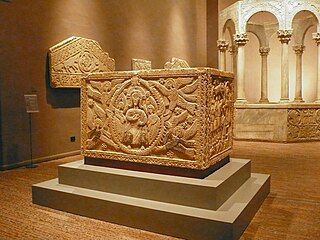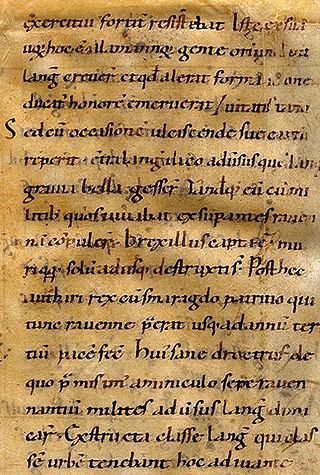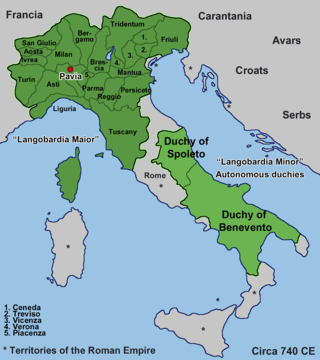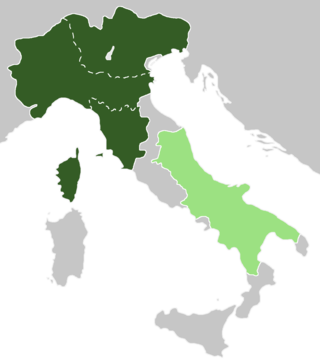Related Research Articles

Alboin was king of the Lombards from about 560 until 572. During his reign the Lombards ended their migrations by settling in Italy, the northern part of which Alboin conquered between 569 and 572. He had a lasting effect on Italy and the Pannonian Basin; in the former, his invasion marked the beginning of centuries of Lombard rule, and in the latter, his defeat of the Gepids and his departure from Pannonia ended the dominance there of the Germanic peoples.

The Lombards or Longobards were a Germanic people who conquered most of the Italian Peninsula between 568 and 774.

Paul the Deacon, also known as Paulus Diaconus, Warnefridus, Barnefridus, or Winfridus, and sometimes suffixed Cassinensis, was a Benedictine monk, scribe, and historian of the Lombards.

Ratchis was the Duke of Friuli (739–744) and then King of the Lombards (744–749).

Agilulf, called the Thuringian and nicknamed Ago, was a duke of Turin and king of the Lombards from 591 until his death.

The History of the Lombards or the History of the Langobards is the chief work by Paul the Deacon, written in the late 8th century. This incomplete history in six books was written after 787 and at any rate no later than 796, maybe at Montecassino.
The Rule of the Dukes was an interregnum in the Lombard Kingdom of Italy (574/5–584/5) during which part of Italy was ruled by the Lombard dukes of the old Roman provinces and urban centres. The interregnum is said to have lasted a decade according to Paul the Deacon, but all other sources—the Fredegarii Chronicon, the Origo Gentis Langobardorum, the Chronicon Gothanum, and the Copenhagen continuator of Prosper Tiro—accord it twelve years. Here is how Paul describes the dukes' rule:
After his death the Langobards had no king for ten years but were under dukes, and each one of the dukes held possession of his own city, Zaban of Ticinum, Wallari of Bergamus, Alichis of Brexia, Euin of Tridentum, Gisulf of Forum Julii. But there were thirty other dukes besides these in their own cities. In these days many of the noble Romans were killed from love of gain, and the remainder were divided among their "guests" and made tributaries, that they should pay the third part of their products to the Langobards. By these dukes of the Langobards in the seventh year from the coming of Alboin and of his whole people, the churches were despoiled, the priests killed, the cities overthrown, the people who had grown up like crops annihilated, and besides those regions which Alboin had taken, the greater part of Italy was seized and subjugated by the Langobards.
Gisulf II was the Duke of Friuli from around 591 to his death. He was the son and successor of Grasulf I of Friuli.
Tasso was the joint Duke of Friuli with his younger brother Kakko from their father's death (611) to their own. Their father was Gisulf II and their mother Romilda of Friuli. In or around 611, Gisulf was killed fending off an Avar invasion.
Kakko was the joint duke of Friuli with his elder brother Tasso from their father's death (611) to their own. Their father was Gisulf II and their mother Romilda of Friuli. In or around 611, Gisulf was killed fending off an Avar invasion.

The Kingdom of the Lombards, also known as the Lombard Kingdom and later as the Kingdom of all Italy, was an early medieval state established by the Lombards, a Germanic people, on the Italian Peninsula in the latter part of the 6th century. The king was traditionally elected by the very highest-ranking aristocrats, the dukes, as several attempts to establish a hereditary dynasty failed. The kingdom was subdivided into a varying number of duchies, ruled by semi-autonomous dukes, which were in turn subdivided into gastaldates at the municipal level. The capital of the kingdom and the center of its political life was Pavia in the modern northern Italian region of Lombardy.
Arnefrit, Arnefrid, Amefrit, or Amefrith was the son of Lupus of Friuli who claimed the Duchy of Friuli after his father's death in 666.

The Duchy of Friuli was a Lombard duchy in present-day Friuli, the first to be established after the conquest of the Italian peninsula in 568. It was one of the largest domains in Langobardia Major and an important buffer between the Lombard kingdom and the Slavs, Avars, and the Byzantine Empire. The original chief city in the province was Roman Aquileia, but the Lombard capital of Friuli was Forum Julii, modern Cividale.
Wechtar, a Lombard from Vicenza, was the Duke of Friuli from 666 to 678. He took control of Friuli at the command of King Grimoald following the rebellion of Lupus and Arnefrit and the invasion of the Avars. According to Paul the Deacon, he was a mild and fair ruler.
Peter or Petrus was the reputed son of Munichis and brother of one Ursus. Paul the Deacon records that Munichis died in the same battle as Ferdulf, Duke of Friuli, and that his son Peter and Ursus later became dukes of Friuli and Benevento respectively. The date of Peter's reign is unknown, but has been hypothesised as following that of Aistulf or Anselm in 756 or 751 and lasted until the Siege of Pavia.
Ado was the Duke of Friuli after the usurper Ausfrid was defeated at Verona in 694. According to Paul the Deacon, he was a brother of the former duke Rodoald and ruled for a year and seven months. The actual length of his reign is disputed, as is the year of its occurrence. He appears with the title loci servator (caretaker) and may have only held the duchy as regent on behalf of the king.
The Codex Gothanus 84 is a 10th/11th century Latin law parchment manuscript in two-column Carolingian minuscule and is one of two extant copies of a lost early ninth-century codex written at Fulda and commissioned by Eberhard of Friuli, probably about 830, from the scholar Lupus Servatus, abbot of Ferrières. It is held by the Gotha Research Library, hence its name.

Austria was, according to the early medieval geographical classification, the eastern portion of Langobardia Major, the north-central part of the Lombard Kingdom, extended from the Adda to Friuli and opposite to Neustria. The partition had not only been territorial, but also implied significant cultural and political differences.
Among the Lombards, the duke or dux was the man who acted as political and military commander of a set of "military families", irrespective of any territorial appropriation.
The Historia Langobardorum codicis Gothani, also called the Chronicon Gothanum, is a history of the Lombard people written at and for the court of King Pippin of Italy between the years 806 and 810. It is preserved in the 10th/11th century Codex Gothanus 84, from which its conventional Latin titles are derived; The chronicle is not titled in the manuscript. The text is ideologically pro-Carolingian, and among its sources are Isidore of Seville and possibly Jerome.
References
- Paul the Deacon. Historia Langobardorum. Translated by William Dudley Foulke. University of Pennsylvania: 1907.
- Hodgkin, Thomas. Italy and her Invaders. Clarendon Press: 1895.
- Gasparri, Stefano. i Duchi Longobardi, Rome, 1978.
- Capo, Lidia. Paolo Diacono: Storia dei Longobardi, Vicenza, 1992.